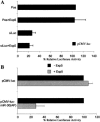Overexpression of exportin 5 enhances RNA interference mediated by short hairpin RNAs and microRNAs
- PMID: 15613540
- PMCID: PMC1370710
- DOI: 10.1261/rna.7233305
Overexpression of exportin 5 enhances RNA interference mediated by short hairpin RNAs and microRNAs
Abstract
Plasmids or viral vectors that express short hairpin RNAs (shRNAs) have emerged as important tools for the stable inhibition of specific genes by RNA interference. shRNAs are structural and functional homologs of pre-microRNAs, intermediates in the production of endogenously encoded microRNAs (miRNAs). Therefore, overexpressed shRNAs could inhibit miRNA function by competing for a limiting level of one or more factors involved in miRNA biogenesis or function. Here, we demonstrate that overexpressed shRNAs can saturate the activity of endogenous Exportin 5, a factor required for nuclear export of both shRNAs and pre-miRNAs. While shRNA overexpression can therefore inhibit miRNA function, simultaneous overexpression of Exportin 5 reverses this effect. Moreover, Exportin 5 overexpression can significantly enhance RNA interference mediated by shRNAs. These data have implications for the future clinical utilization of shRNAs and also provide a simple method to enhance RNA interference by shRNAs in culture.
Figures






References
-
- Abou Elela, S., Igel, H., and Ares Jr., M. 1996. RNase III cleaves eukaryotic preribosomal RNA at a U3 snoRNP-dependent site. Cell 85: 115–124. - PubMed
-
- Bartel, D.P. 2004. MicroRNAs: Genomics, biogenesis, mechanism, and function. Cell 116: 281–297. - PubMed
-
- Brummelkamp, T.R., Bernards, R., and Agami, R. 2002. A system for stable expression of short interfering RNAs in mammalian cells. Science 296: 550–553. - PubMed
Publication types
MeSH terms
Substances
Grants and funding
LinkOut - more resources
Full Text Sources
Other Literature Sources
Molecular Biology Databases
Miscellaneous
